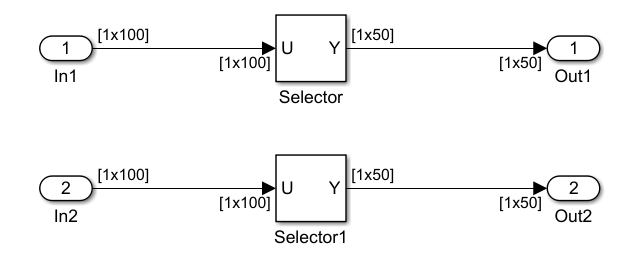Use memcpy Function to Optimize Generated Code for Vector
Assignments
You can use the Use memcpy for vector assignment
parameter to optimize generated code for vector assignments by replacing
for loops with memcpy
function calls. The memcpy function is more efficient
than for-loop controlled element assignment for large
data sets. This optimization improves execution speed.
Selecting the Use memcpy for vector assignment parameter
enables the associated parameter Memcpy threshold
(bytes), which allows you to specify the minimum array
size in bytes for which memcpy function calls should
replace for loops in the generated code. For more
information, see Use memcpy for vector assignment and Memcpy threshold (bytes). In considering whether to use this
optimization,
Verify that your target supports the
memcpyfunction.Determine whether your model uses signal vector assignments (such as
Y=expression) to move large amounts of data, for example, using the Selector block.
To apply this optimization,
Consider first generating code without this optimization and measuring its execution speed, to establish a baseline for evaluating the optimized assignment.
Select Use memcpy for vector assignment and examine the setting of Memcpy threshold (bytes), which by default specifies 64 bytes as the minimum array size for which
memcpyfunction calls replaceforloops. Based on the array sizes used in your application's signal vector assignments, and target environment considerations that might bear on the threshold selection, accept the default or specify another array size.Generate code, and measure its execution speed against your baseline or previous iterations. Iterate on steps 2 and 3 until you achieve an optimal result.
Note
The memcpy optimization may not occur under
certain conditions, including when other optimizations have a higher
precedence than the memcpy optimization, or
when the generated code is originating from Target Language Compiler
(TLC) code, such as a TLC file associated with an S-function
block.
Note
If you are licensed for Embedded Coder® software, you can use a code replacement library (CRL)
to provide your own custom implementation of the
memcpy function to be used in generated
model code. For more information, see Memory Function Code Replacement.
Example Model
To examine the result of using the Use memcpy for vector assignment parameter on the generated vector assignment code, create a model that generates signal vector assignments. For example,
Use In, Out, and Selector blocks to create the following model.

Open Model Explorer and configure the Signal Attributes for the
In1andIn2source blocks. For each, set Port dimensions to[1,100], and set Data type toint32. Apply the changes and save the model. In this example, the model has the namevectorassign.For each Selector block, set the Index parameter to
1:50. Set the Input port size parameter to100.
Generate Code
The Use memcpy for vector assignment parameter is on by default. To turn off the parameter, go to the Optimization pane and clear the Use memcpy for vector assignment parameter.
Go to the Code Generation > Report pane of the Configuration Parameters dialog box and select the Create code generation report parameter and the Open report automatically parameter. Then go to the Code Generation pane, select the Generate code only option, and generate code for the model. When code generation completes, the HTML code generation report is displayed.
In the HTML code generation report, click the
vectorassign.csection and inspect the model step function. Notice that the vector assignments are implemented usingforloops./* Model step function */ void vectorassign_step(void) { int32_T i; for (i = 0; i < 50; i++) { /* Outport: '<Root>/Out1' incorporates: * Inport: '<Root>/In1' */ vectorassign_Y.Out1[i] = vectorassign_U.In1[i]; /* Outport: '<Root>/Out2' incorporates: * Inport: '<Root>/In2' */ vectorassign_Y.Out2[i] = vectorassign_U.In2[i]; } }
Generate Code with Optimization
Go to the Optimization pane of the Configuration Parameters dialog box and select the Use memcpy for vector assignment option. Leave the Memcpy threshold (bytes) option at its default setting of
64. Apply the changes and regenerate code for the model. When code generation completes, the HTML code generation report again is displayed.In the HTML code generation report, click the
vectorassign.csection and inspect the model output function. Notice that the vector assignments now are implemented usingmemcpyfunction calls./* Model step function */ void vectorassign_step(void) { /* Outport: '<Root>/Out1' incorporates: * Inport: '<Root>/In1' */ memcpy(&vectorassign_Y.Out1[0], &vectorassign_U.In1[0], 50U * sizeof(real_T)); /* Outport: '<Root>/Out2' incorporates: * Inport: '<Root>/In2' */ memcpy(&vectorassign_Y.Out2[0], &vectorassign_U.In2[0], 50U * sizeof(real_T)); }
See Also
Use memcpy for vector assignment